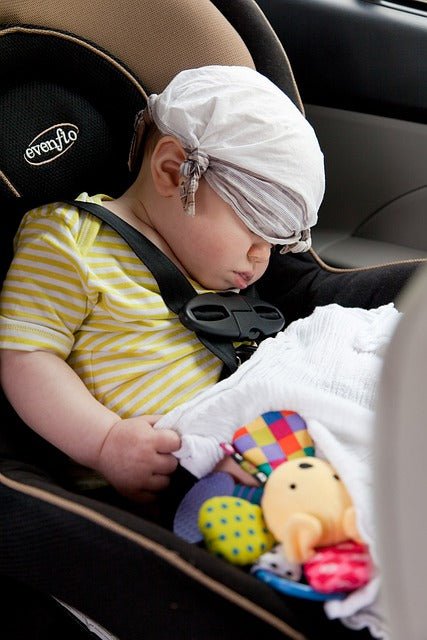If you have a pushchair that gets a lot of use, there will likely be some mould somewhere on it. It can be a concerning thing to deal with, especially seeing as you want to protect your little ones as much as possible from getting sick. There is no doubt that mould is harmful, however, it’s easy to take control of. In this blog, we look at how to get rid of mould on a pushchair.
What is mould?
If you are reading this, you may be experiencing a mould problem on your
pushchair. Mould is a fungus that grows on organic matter, typically in damp and dark places such as basements and bathrooms. It can grow on many different surfaces such as fabric, wood or even paper products like magazines. You may have seen mould in the folds of your pushchair if it was stored in an area with poor ventilation (e.g., under the stairs).
Why does mould grow on pushchairs?
Mould can grow on pushchairs, strollers and car seats for several reasons. If it is warm and humid enough, the mould spores will start to grow. The type of material that your pushchair is made from will also determine how susceptible it is to mould growth. For example, certain types of fabrics attract mould more than others. Mould grows in warm, moist places - so if your child's pushchair has been left outside in the rain or snow for long periods, there may be some dampness inside which could encourage the growth of visible mould.
How to get rid of mould on a pushchair
There are a few ways to help remove mould on a pushchair. Here are some steps to take:
1. Brush down the pushchair
To start, brush off any visible mould and dirt. Ideally, a soft-bristled brush is best so as not to damage the fabric. Use a soft brush, preferably made of natural materials like horsehair or bamboo. This will help to loosen the grime without any damage to the pushchair.
2. Use a mould-removal solution
Use a good mould-removal solution to help remove any deeper mould and dampness. A good way to get rid of mould is by using a mould-removal solution such as lemon juice and vinegar, or a chlorine-based solution. Make sure you dilute the cleaning agent with water before applying it to the pushchair. You can either use a cloth or sponge to apply the solution liberally on areas where there is visible mould growth. Apply the liquid-based solution from a spray bottle, or soak a clean towel in it and then wring it out before wiping over the infected area. Once targeting the more visible areas, try and coat the whole pushchair in the solution. This will also help to prevent future mould growth.
3. Wipe off any excess
If you have been using a cloth to wipe the mould off, then you can easily remove any excess solution. However, if you have used any other method of removing the mould and it has left some residue behind, then give this area a quick scrub with a cloth. The cloth should be disposed of immediately after being used so as not to spread spores around your home or workplace unnecessarily.
4. Repeat whenever there are signs of mould growth
As you clean your pushchair and make sure it is dry before storing, repeat this process as often as necessary to keep your pushchair free of mould. If you start seeing visible signs of mould or dampness again, repeat all of these steps as soon as possible.
Preventing mould growth
If you want to prevent mould growth on your pushchair, there are some steps you can take. Firstly, keep it in a dry place. If possible, store it away from sunlight or other sources of heat that could warm the fabric and encourage the growth of mould. Make sure to always dry your pushchair thoroughly after washing it. This will help prevent any mould spores from taking root in damp patches on your pushchair. If you have small children with allergies or asthma, ask them not to touch any parts of the pushchair if you know there are signs of mould on there. This could trigger their allergies or asthma if mould spores get into their body. If you live in a damp house where there is constant condensation on windows etc., this can lead to mould growth all over your property. This can even include inside furniture with certain materials such as fabric sofas. The mould may transfer onto clothes worn by family members when they sit down. You want to prevent the spread of mould as fast as possible by wiping down potentially infected areas with the cleaning solution. Making sure to thoroughly dry your pushchair before putting it away also helps to prevent any mould growth. If the pushchair has spent all day in the rain and is stored straightaway, the dampness is never going to dry and encourages mould growth.
Storing the pushchair
Use a waterproof cover to store your pushchair when not in use. This helps to prevent any mould spores from spreading around the house and onto the pushchair. Store the pushchair away from dark and damp places. Ideally, try and store it in well-ventilated areas near sunlight so it can dry properly. Storing your pushchair in a cool and dry place is the best way to prevent mould from growing on it. It’s also important that you clean your pushchair regularly so that any mould growth can be spotted early on. We hope this blog helped you learn how to get rid of mould on the pushchair. For more information visit our website for further advice on how to get rid of mould on a pushchair and storing pushchairs.



